Most people, when they think about how to create an online course, are pretty excited about the idea of money dropping into their bank account while they sleep. That absolutely can happen. In fact, the median amount that Podia customers make from paid courses is $525 per month, and we've seen individual courses sell for over $35,000!
But here’s the thing: knowing how to create an online course is only one part of the problem.
Even with a brilliant idea and time on your hands, sitting down and actually writing or filming the course materials is tough. And frankly, a lot of people who start creating a course don’t ever end up publishing it.
Still, that doesn’t mean you shouldn’t create an online course. But while you’re writing the sections and lessons, creating the quizzes, shooting the videos, building the landing page, and setting the course pricing, there are a few things you can do to make sure you actually launch.
In this article, you’ll learn the system that we’ve seen thousands of creators use to successfully launch profitable online courses. We’ll cover:
-
The most common pitfalls that people fall into when they’re making an online course
-
How you can avoid the most deadly course creation mistakes
-
How to build your online course
By the end of this step-by-step guide to online course creation, you’re going to have all the tools you need to build a successful online course and a plan for making sure that it sells when you launch it.
The problem with making online courses
In a moment, we’ll show you how to build an online course with Podia’s easy-to-use online course platform. But before you dive in, it’s worth knowing what happens to a lot of people who create a course:
-
You spend all this time and effort on a course, then when you launch it no one buys.
-
You feel defeated because now months have passed and you didn’t make any money off this course you poured your heart and soul into.
This is exactly what happened to me when I made my first online course a few years ago.
I spent two months working on my course, spending hours scripting, filming, editing, and uploading all my content.
I had an email list, but I was so focused on finishing the course I never stopped to tell them about it until it was done. I never asked them what they wanted either.
I also spent a lot of money to get advanced features that I didn’t need, and I had to deal with separate software for my course, website, email marketing, and affiliates.
Then I launched, and while I did have a few sales, I didn’t make enough money to cover my expenses.
This is more common than you think and it can leave solopreneurs feeling disheartened. I mean, after all, you see so many examples of people on social media who are swimming in cash like Scrooge McDuck.
And you ask yourself: is the problem me?
We’ve seen thousands of people build immensely profitable online courses, and we can tell you this:
The problem isn’t you. It’s not your fault.
It’s just that you’re missing some of the key steps to building a successful online course that those people you look up to have figured out.
And listen, I’ve been there: I didn’t know it at the time when I failed to build an online course that sells, but I was making some huge missteps.
There’s a better way, and we’ve seen this repeatedly backed up with our thousands of successful course sellers at Podia.
You can solve the problem with this simple system. And it starts with avoiding these common course mistakes.
No secrets here – these deadly online course creation mistakes are more common than you think
When things don’t go the way you want, it’s probably for one of these reasons:
-
You haven’t spent time building your audience – You focused all your energy on getting every detail right with your course, but when it was finished, you had no one around to tell about it. Build it and they will come? Yeah… that didn’t work.
-
You tried to cover too much information in your course – Seventy-five lessons later and you’ve still just scratched the surface. You feel like you’ll never finish and there’s just so much to say, but now you’re left with half of a monster course and no energy left to finish it.
-
You built it in secret – Building a course is tough, and you don’t want to be embarrassed in front of your friends and followers if it doesn’t work out. So you never mention what you are working on. They won’t know you failed if they didn’t know you tried, right? But now your audience doesn’t know you have a course and they aren’t ready to buy. You haven’t gotten any feedback from them and no one has the same excitement as you do.
-
Your tech is too complicated – You spent hundreds of dollars on course software, an email list tool, landing page builders, sales funnels, ads, and other expensive extras because the gurus said you need them, but nothing moves the needle. Now you’ve lost time and money with nothing to show except for a mess of complicated software.
This might sound strange, but creating a successful online course isn’t only about the course.
Your success depends on the system you built to market and promote the course. So this is what to do instead to make sure your work reaches the right people.
How to create an online course
Online courses are often one of the first types of products that people make, and when we look at the data, the average monthly revenue for those that started with a course is 2.1x higher than those that started with a different product type.
At Podia, we’ve seen thousands of entrepreneurs succeed with this simple formula for creating profitable online courses.
-
Set up a lead magnet related to your course to start growing your audience
-
Create your course outline (keeping things simple with just one focus topic)
-
Share your outline with your audience to get feedback and build your waitlist
-
Film, write, record, then upload your course to Podia
-
Launch your course to your waitlist and then to your broader audience
In the end, you’ll also get ideas to grow beyond launch day for even more sales.
Step 1: Start with building an audience
Before you do anything else, set up a lead magnet to grow your email list. Podia users who regularly send emails with Podia Email make an average of $356 more per month than those who don’t, and all these steps work better if you have some sort of audience – even if it’s just a handful of people.
Your lead magnet should be a free resource about a similar topic to your course. The simpler the better here – give yourself an hour or two to make a resource, freebie, webinar, checklist, printable, or short tutorial with the same theme as your course.
Then, add your free lead magnet to your website to start growing your list. You can put your lead magnet on the bottom of every blog post, your home page, your website footer, your social media bio links, and anywhere else your audience members can find you.
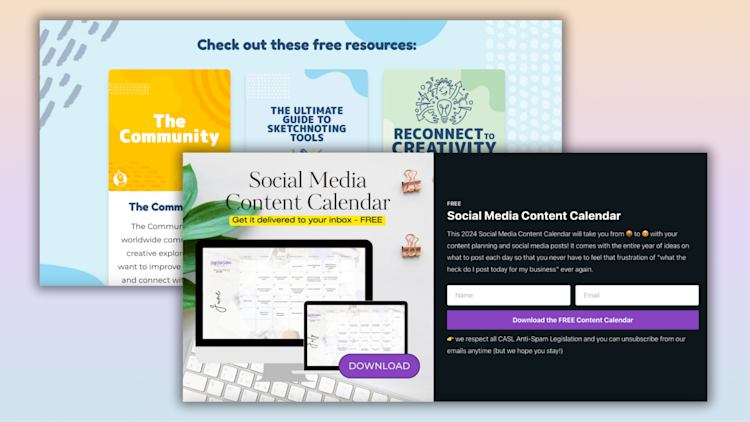
Now, people interested in your course topic can get on your list so you can build a relationship with them before making the sale.
“Too many creators spend weeks or months building in isolation only to struggle to get buyers when they're ready to sell,” expert course creator and Podia Pro Glen Long shares.
“The truth is, it doesn't matter how good your product is if people don't trust you enough to take a chance on it. That's why it's smart to build trust and recognition first.”
For his lead magnet, Glen created a free mini-course.
“When I started my business, I had no audience. So I created a course I felt would be worth at least $100 to the right person. Then I reached out to an ex-employer and a client to see if they wanted to give it to their audiences for free. They agreed because giving their audience something valuable for free made them look good. It was hard work building the course and supporting the students, but it got me my first 500 email subscribers. And that free course still brings me new subscribers to this day.”
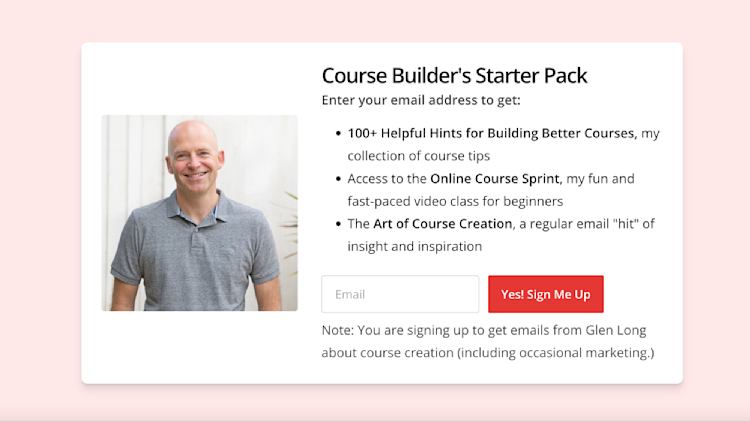
While your lead magnet doesn’t have to be an in-depth course like Glen’s, you can use this same concept of creating something your ideal customer would love and making it available so people start to know, like, and trust you.
You can read about how to set up your lead magnet in Podia in this help doc.
Step 2: Create your course outline, but don’t make the whole thing yet
Next, set up your outline for your online course. Stick to one clear, manageable topic or outcome per course.
A course about “How to be organized” has about a million different directions, modules, and lessons you could create, but “How to organize your pantry in two hours” feels much more concise and achievable (both for course creators and students alike!)
For example, course creator and Podia Pro Em Connors teaches a course about how to create 30 days of content in a day. The course takes about 40 minutes to complete, and there are seven sections that all lead students to one clear outcome.
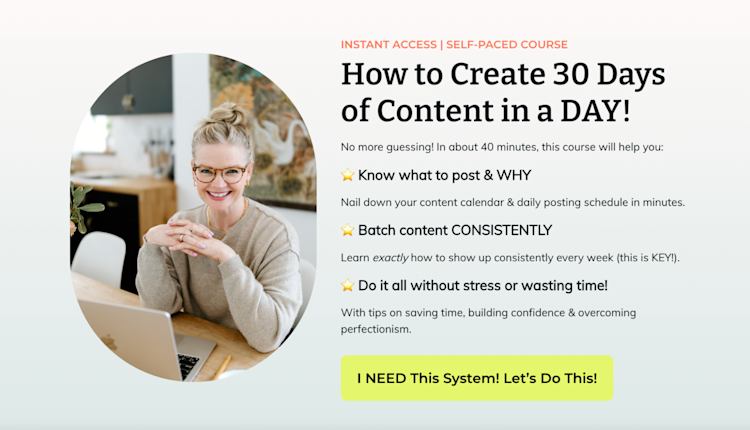
And Global Art Classroom offers mini art courses for children with five to six lessons. Students learn how to draw the design, paint the design, and paint the background of a different image in each course.
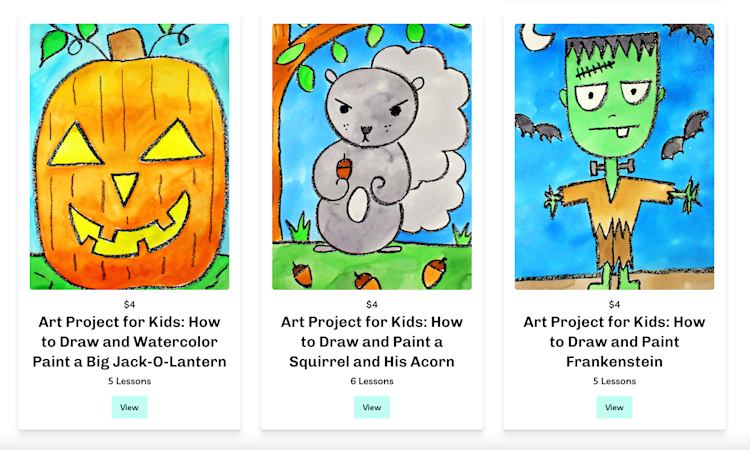
For your outline, write a rough idea of each module and lesson you’d like to teach. Think about any additional resources, like worksheets, printables, or downloads, you’d like to include too.
If you’re feeling overwhelmed as a beginner course creator, Marie Rolla from Black Sheep Salon recommends: “Start small and start with a topic you are confident in! Do a 1-hour class or something else short and sweet just to get your toes wet. Learn from that experience and let it shape how you plan to tackle your bigger projects.”
Again, you don’t have to build the full course right now, just draft an outline of what your course will include.
You’ll want audience feedback on your outline before you spend a ton of time on the details, which takes us to the next step.
Step 3: Share your outline with your audience to get feedback and build a waitlist
It’s disappointing to make a course that your audience members aren’t interested in, and the best way to prevent this from happening is to simply ask them what they want.
Now that you have your course outline, the next step is to share it with your customers and get their feedback. Send out an email, post on social media, write a blog post, or connect any way you prefer.
Casey Richardson from Blaze Academy posted that she was creating a course to help Black women with business management. She asked social media followers to book a 15-minute call to learn about their needs in this area, and she also asked questions like:
-
“What keeps you up at night?”
-
“What is your biggest fear?”
-
“In one year, where do you want to be?”
Casey says, “By the end of most of those calls, they were like, ‘Can I buy the course now?’” And when she launched, 80% of the people she spoke to became customers.
Em Connors used Instagram stories to ask followers what they needed help with and what they’d like to learn about. "I'm always talking to my audience,” she shares. “I love using stories on Instagram. Your stories are for your people, the ones who are really paying attention."
And course creator Julian Crosson-Hill got audience feedback early on by co-creating programs with a small group of people.
“I pilot new courses and programs through a process where I co-create the program with a small cohort of people. This allows me to get better feedback earlier and prevents me from wasting a lot of time building a program no one wants. It’s critical to get feedback earlier in the creation process to make sure that the product is a good fit for your ideal customer. The goal should be for your ideal customer to see what’s been created and think, ‘Wow! I feel like this was made just for me!’.”
Once you have feedback from your target customers, use it to adjust your outline. If people mention the same pain point again and again, it’s worth including it in your product.
As you gather feedback, you should also collect valuable email addresses. The people who take time to share feedback on your course are potential buyers, so let them be the first to know when your course is open for enrollment with a waitlist.
In Podia, you can set your course to waitlist mode while you’re building and people can sign up to show interest. On your course landing page (which you can set up in Podia in just a few clicks), you can share your outline, learning objectives, FAQs, and information about what learners can expect.
When it’s available for sale, you can send these people an email letting them know.
Check out this help doc for more info on waitlists.

Podia also has a pre-selling feature where people can buy your course before it’s fully ready. Think of this like pre-ordering a book from your favorite author. If you set up pre-sales in Podia, people can purchase your course while you’re still in the building phase, and receive access when it’s live.
If you do decide to go this route, a word of advice: Set up a sales page and choose a launch date that is uncomfortably close so that you have to commit to launching. Nothing like a few early customers and some cash in the bank to keep you motivated to build fast.
Jess Shanahan from Racing Mentor used pre-sales to fund other marketing efforts for her online course. She says,
“The biggest thing that helped me get going was to pre-sell my first course. I sold it for £25 before it was even built and managed to make around £500. It doesn't seem like much now but it gave me what I needed to put time into the course. It eventually sold for £129 full price and has made about £3500 since it started. Getting that money upfront not only shows me that the product is worth the time, but it gives me the finances to create the content and pay for marketing.”
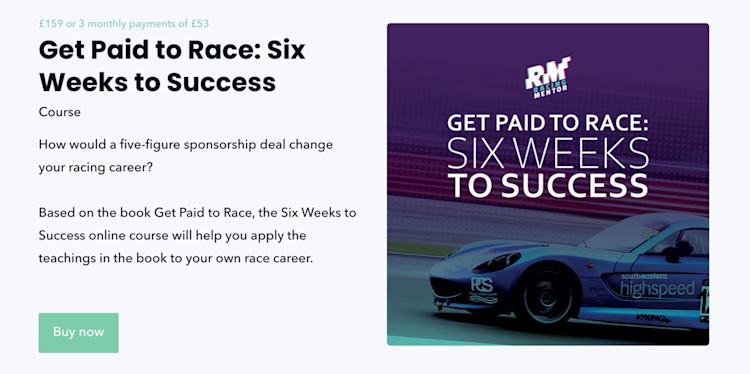
One of our team members at Podia launched their first course in seven days and made nearly $7,000 in pre-sales… without any lessons completed. You can imagine how quickly that course got built!
Step 4: Film, write, or record your course
You’re finding your target audience, outlining your course, and getting feedback about what your potential customers want to learn about. You’ve also started growing your waitlist (or making pre-sales), so it’s time to build.
The type of course you make depends on your preferences and the content you teach. We’ve seen wildly successful video courses, text-based courses, and everything in between, and Podia makes it easy to add images, audio, videos, quizzes, text, embeds, files, and anything else you want to your course lessons.
Since video creation is a common course medium, here’s a tip:
When you make your video, start with a script or outline so you don’t forget anything. Jump right into the meat of your lesson within the first minute or two of your video.
You don’t need fancy gear, just use your phone or the camera on your computer. You can use screen share tools like Loom or Streamyard to record your screen. Record, give it an editing pass, and upload your video to your online course software.
With Podia, you’ll build your course by creating sections (or modules) and adding individual lessons within each section. You can add as much or as little as you like, and you can your course description, feature image, pricing, and availability in the course settings.

This help doc covers everything you need to know about Podia’s course builder functionality and the course creation process.
Podia also comes with landing pages and checkout built in, so you can make a page to promote your product and collect payments without wiring up a bunch of tech. This means fewer headaches and expenses in your business.
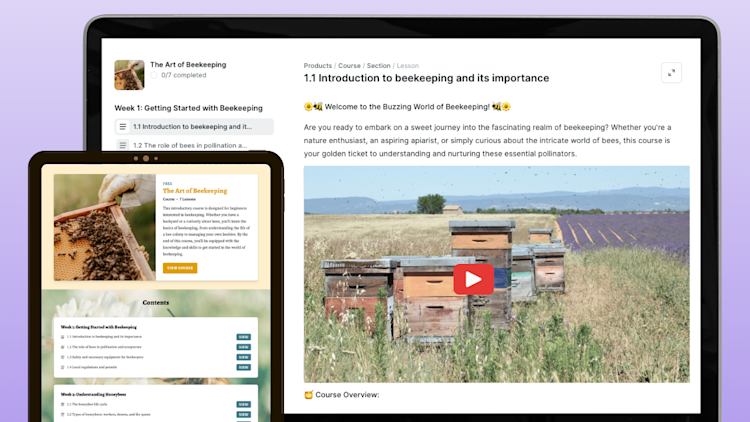
As Podia Pro Robert Williams explains,
“My business runs best on as few tools as possible. (That's why Podia is so important.) I’ve redesigned my product a dozen times, including building a custom Rails application that handled billing, sending emails, and online course delivery for my students. This year, I've ultimately pared all of that down to just Podia. If I had skipped all of this, I could've saved hundreds of thousands of dollars and even more time.”
Simply put, managing and paying for a bunch of tools takes time away from making your courses. It also increases your expenses so it takes longer to break even and see a return on your investment. An all-in-one tool like Podia lets you run everything under one roof.
Step 5: Launch to your waitlist, then to everyone else
Your course is ready to go, so the last thing to do is to press that publish button.
We’ve seen a lot of creators have success with offering a discount or coupon to waitlist members to reward your earliest and most enthusiastic students. Plus, discounts are a good motivator to get more people onto your list during your launch period.
Even if they don’t buy your course today, they might buy other products from you in the future.
Podia has coupons built in so you can easily add a percentage or dollar amount discount. You can read more about adding coupons in Podia here.
Em Connors made five figures on her first online course launch using this system. She says, "About a month before launch, I create a waitlist. On Instagram, I start hyping the course up, showing people behind the scenes, and talking about launch emails. I share a link so followers can join my waitlist and get a discount if they sign up during the presale."
This will give you your first wave of customers, you can use their feedback to make improvements and add testimonials to your sales page.
Throughout your course launch, make sure you tell your followers on all channels about the product you’ve created.
-
Send emails to your list
-
Post blog posts about your course
-
Talk about it on social media
-
Share with your professional connections on LinkedIn
-
Create YouTube video content or podcast episodes to preview your course
-
Share info about your course in forums and Facebook groups related to your topic
-
Ask people in your network to share your course with their followers
You’ve put a lot of work into this, so don’t be shy about sharing it.
Your course can keep earning you money. Here’s how:
After the excitement of launch day wears off, you still want your course to make money long into the future. Here are a few ways to do that:
Add your course to your welcome sequence or sales funnel
Remember the lead magnet you set up earlier?
Now that you’ve finished a course related to that lead magnet, you can use your freebie as the first step in a sales funnel.
To do this, set up a sequence that runs automatically whenever someone grabs your lead magnet. In Podia Email, you can do this with a campaign and using the entrance condition “signs up for [lead magnet name].’
Then you can automatically send time-delayed messages with helpful resources, information about your business, and promotions for your course.
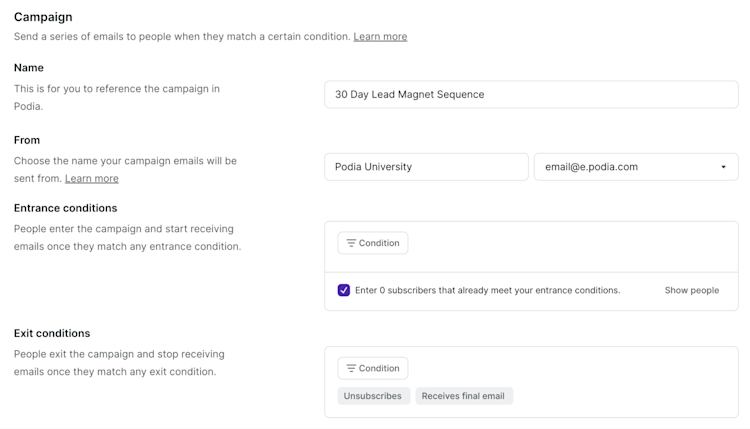
Upsell your course with other products, and vice versa
As you create other products in your business, you can offer your course as an upsell at checkout. Podia has an upsell feature so you can cross-promote other products at the time of purchase (and even offer exclusive discounts).
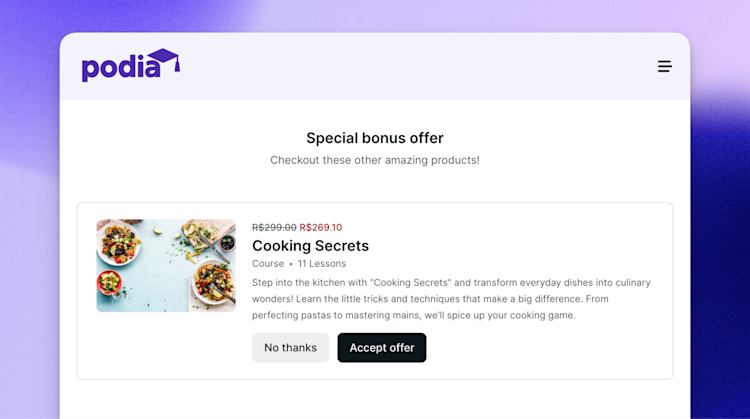
Grow your reach with affiliate marketing
When you set up an affiliate program in Podia, you can let happy customers and other online business owners in your niche promote your course for you. In exchange, they earn a commission on every sale that comes through one of their unique links. This gives you access to a much wider audience, and you can set your affiliate commissions to whatever rate or percentage you want.
(On average, Podia customers with affiliate programs earn over $75/month from affiliate-driven sales alone. This completely covers the cost of an annual Podia Shaker plan.)
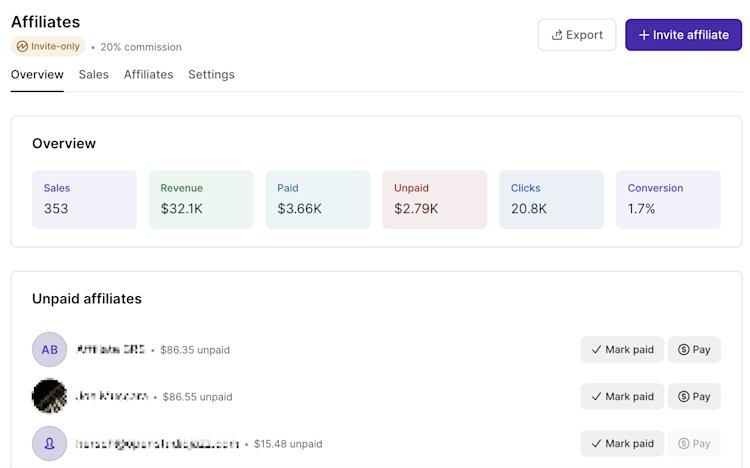
Creating a course is just a small part of having a successful course business
Making a course is hard work, and it’s frustrating to get to the finish line and not see the results you want.
Starting without an audience, not asking for customer feedback, overcomplicating your course content or tech, and creating your course without telling anyone about it can all make your launch day and course sales less than what you hoped for.
Instead, follow this gameplan that we’ve seen Podia entrepreneurs use to create courses that earn hundreds or thousands of dollars year after year.
-
Grow your audience with a relevant lead magnet
-
Create your course outline, thoroughly covering one topic
-
Share your outline with your audience to get feedback and get people on your waitlist
-
Film, write, record, then upload your course to Podia
-
Launch your course to your waitlist with a discount and share it with your full audience
-
Continue to grow by adding your course to your sales funnels and welcome sequences, adding upsells, and setting up affiliates
You can do all this and much more with Podia, and everything is already connected so you don’t have to waste time learning tons of different tech. Build your website, online store, email list, and everything else – start your 30-day trial of Podia today.




